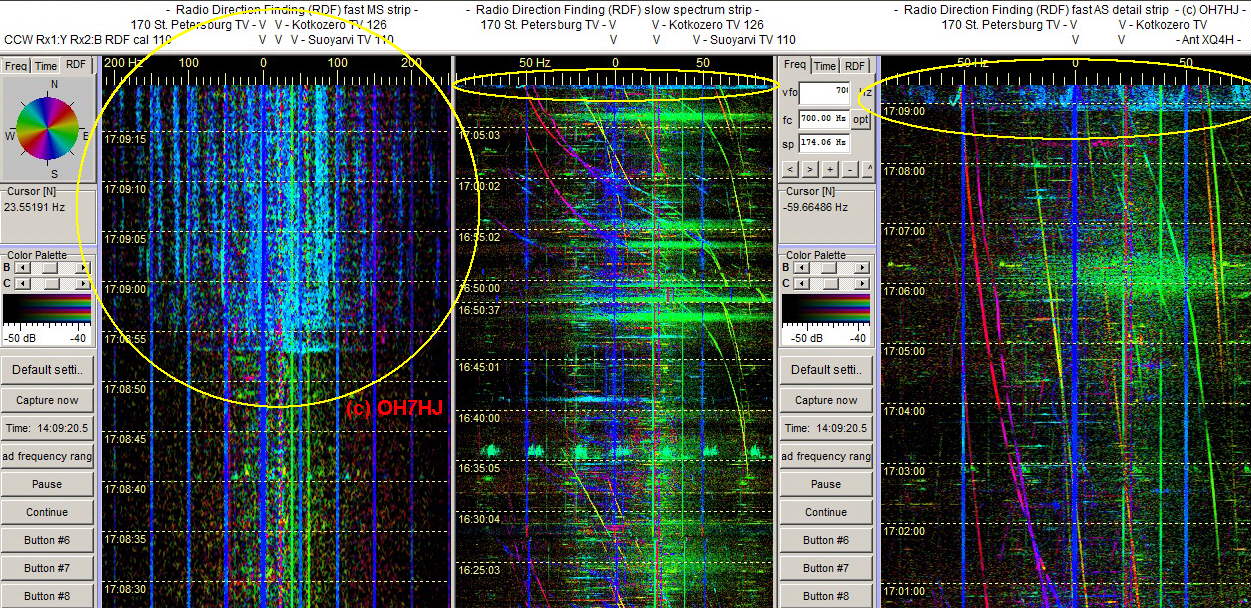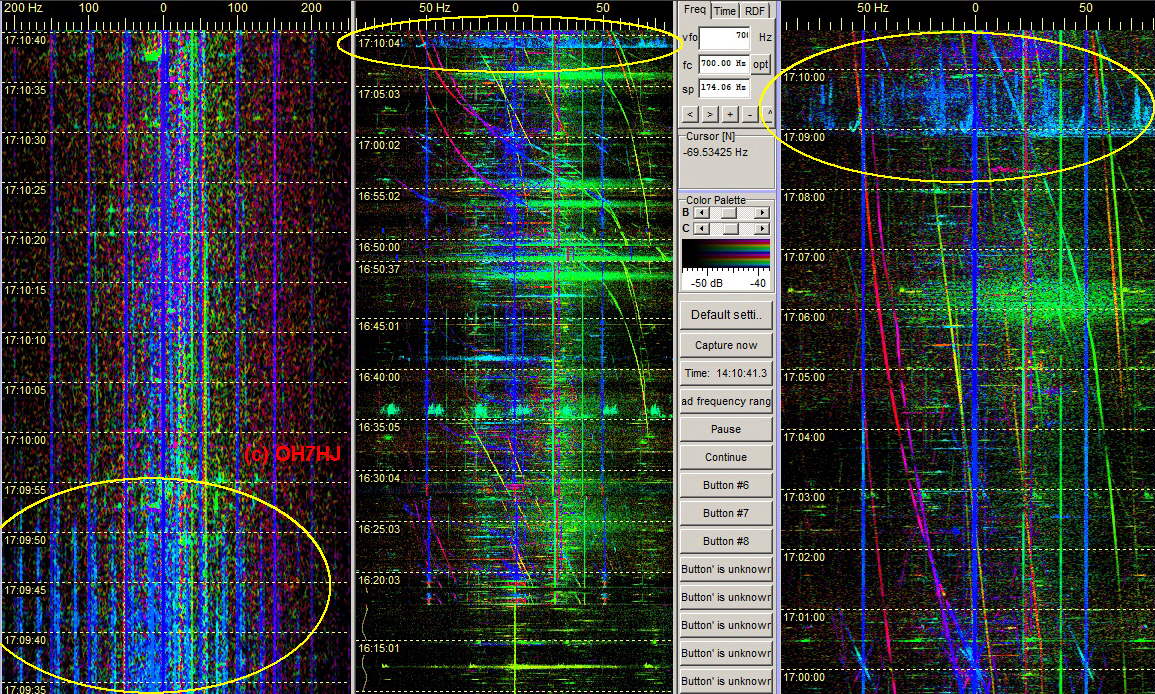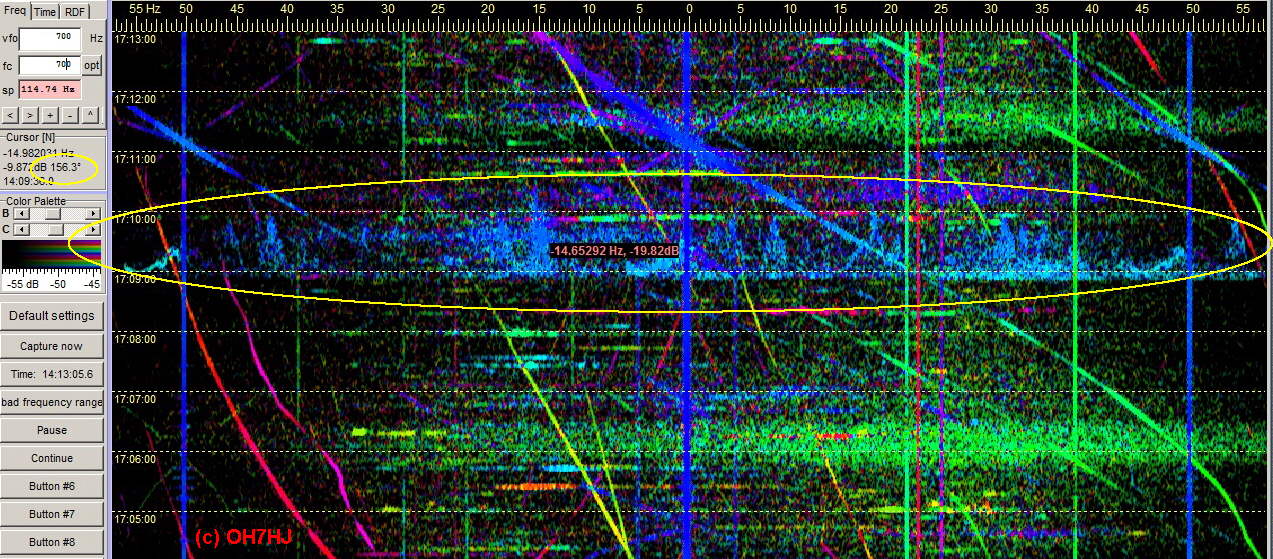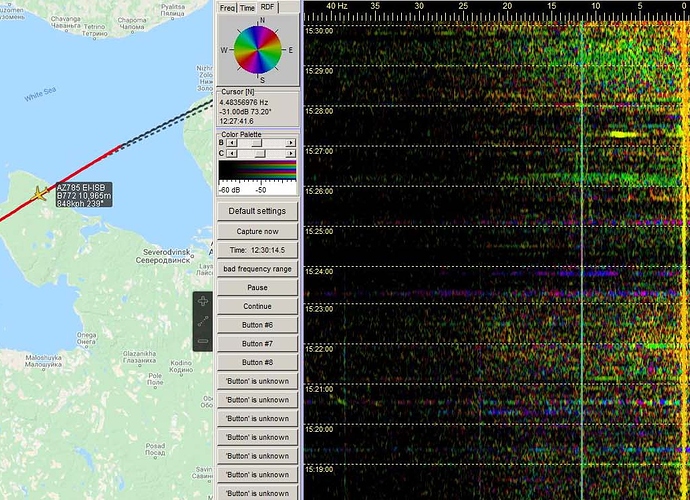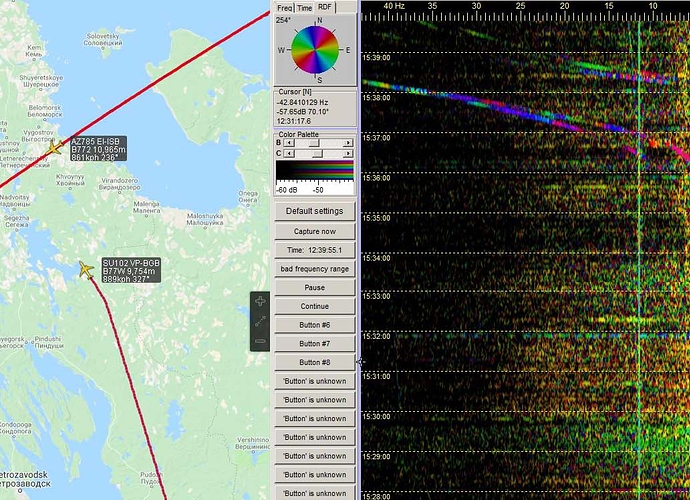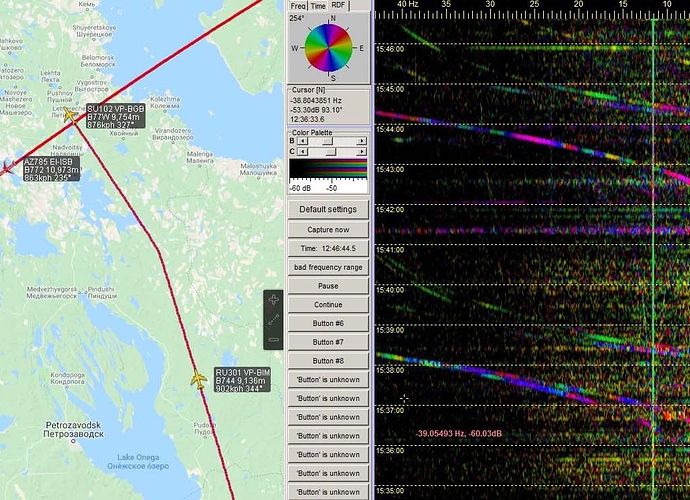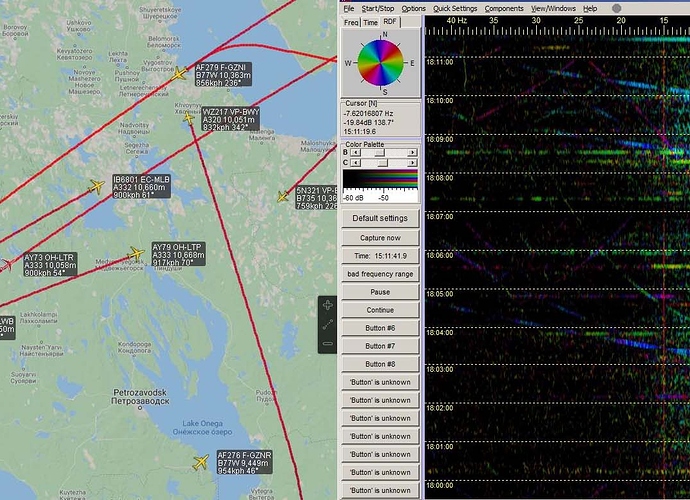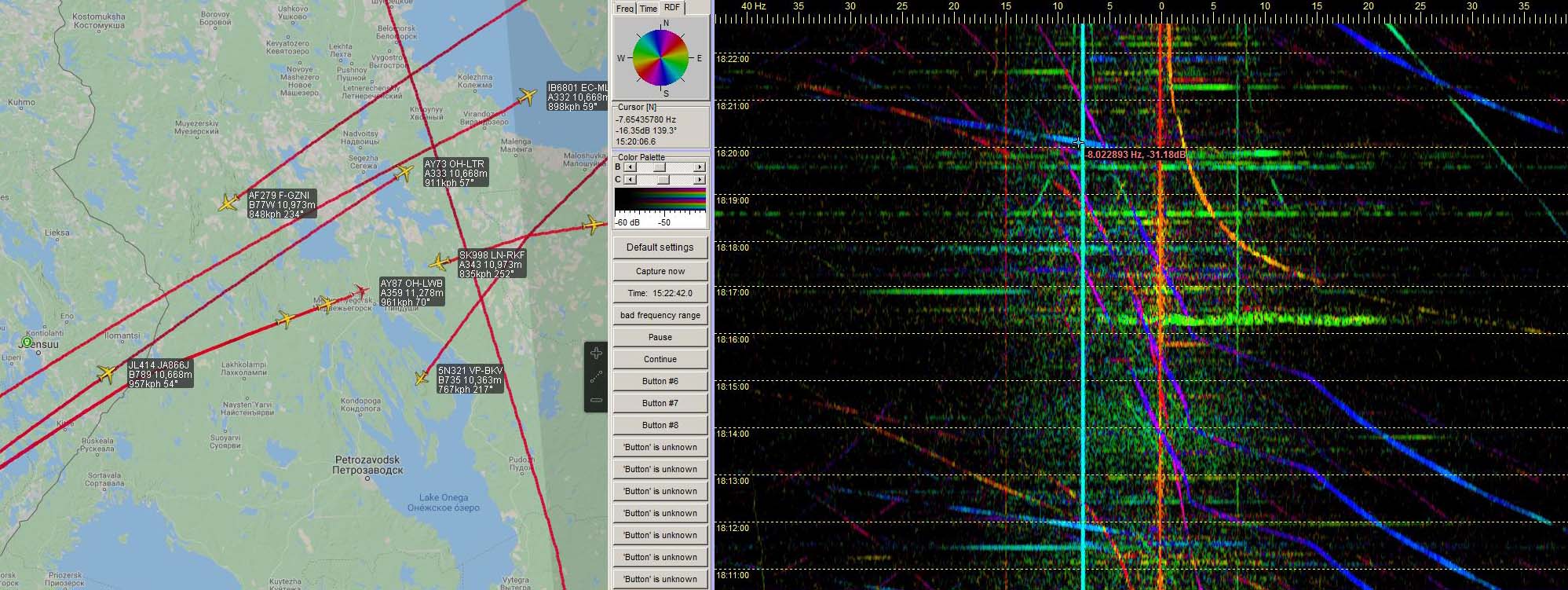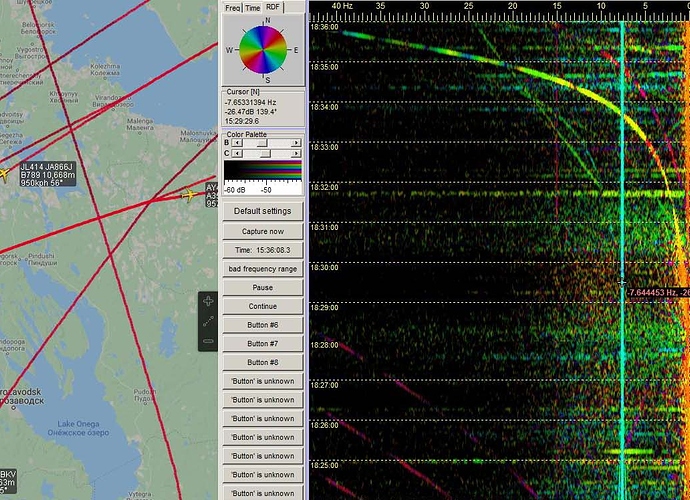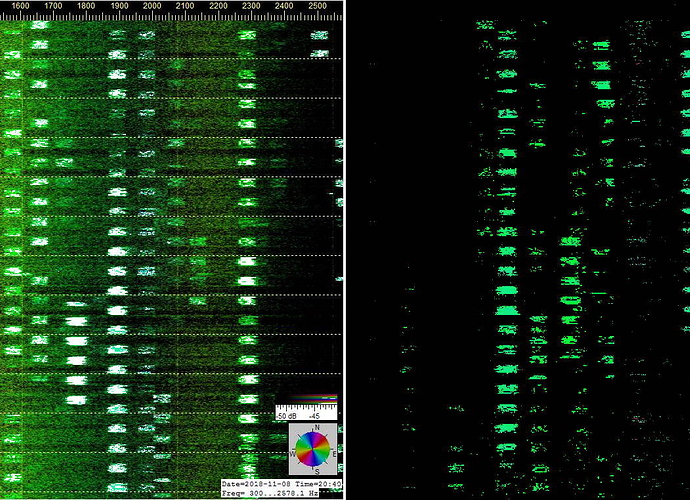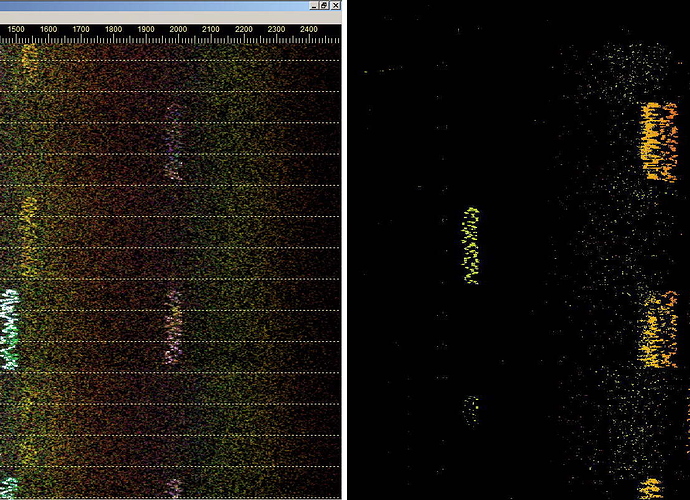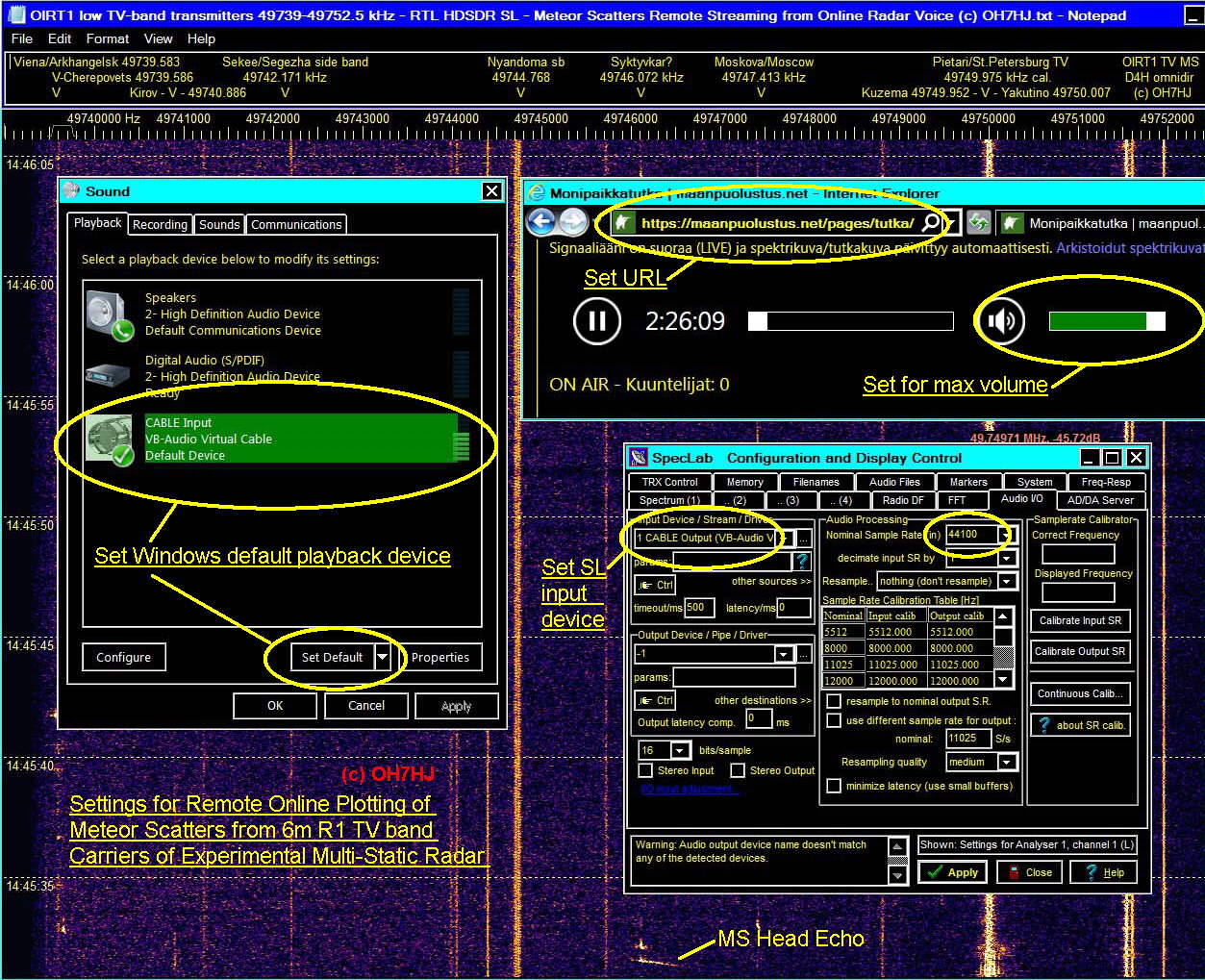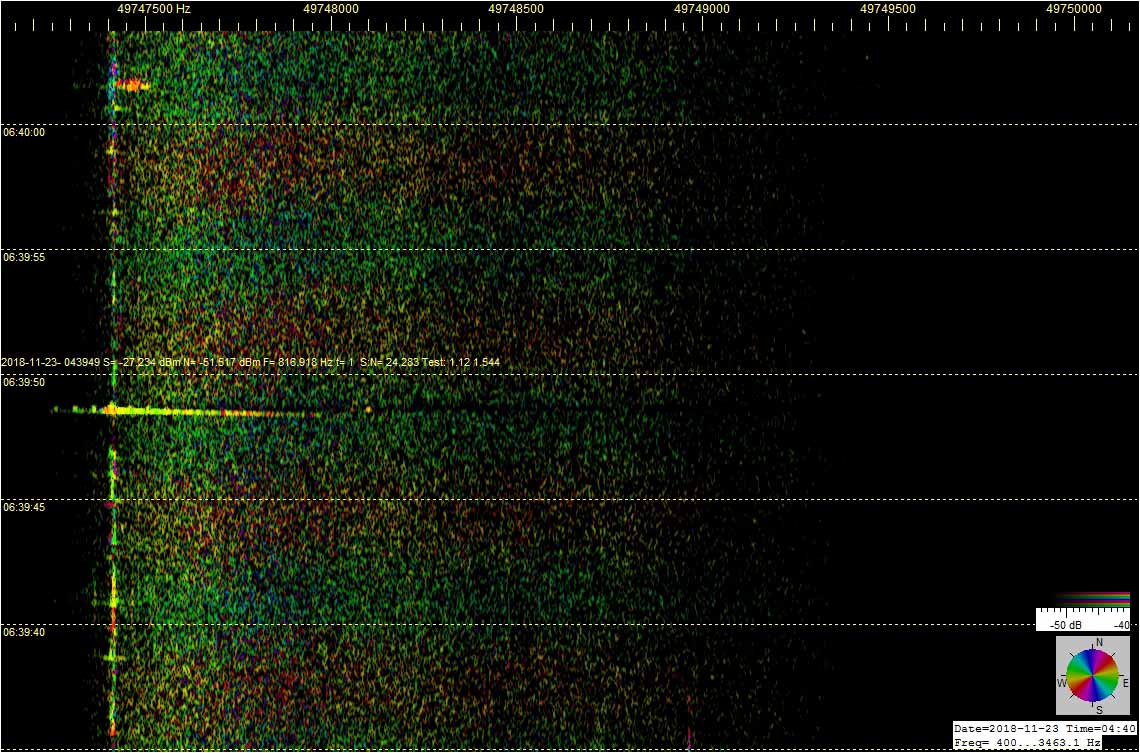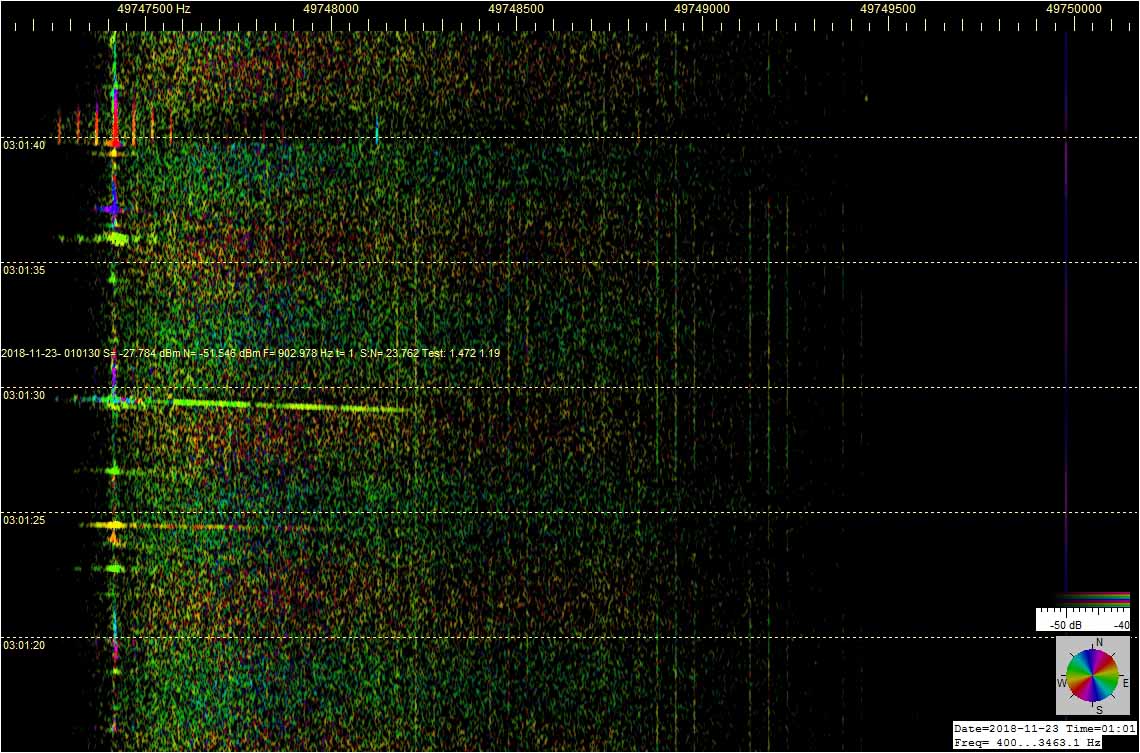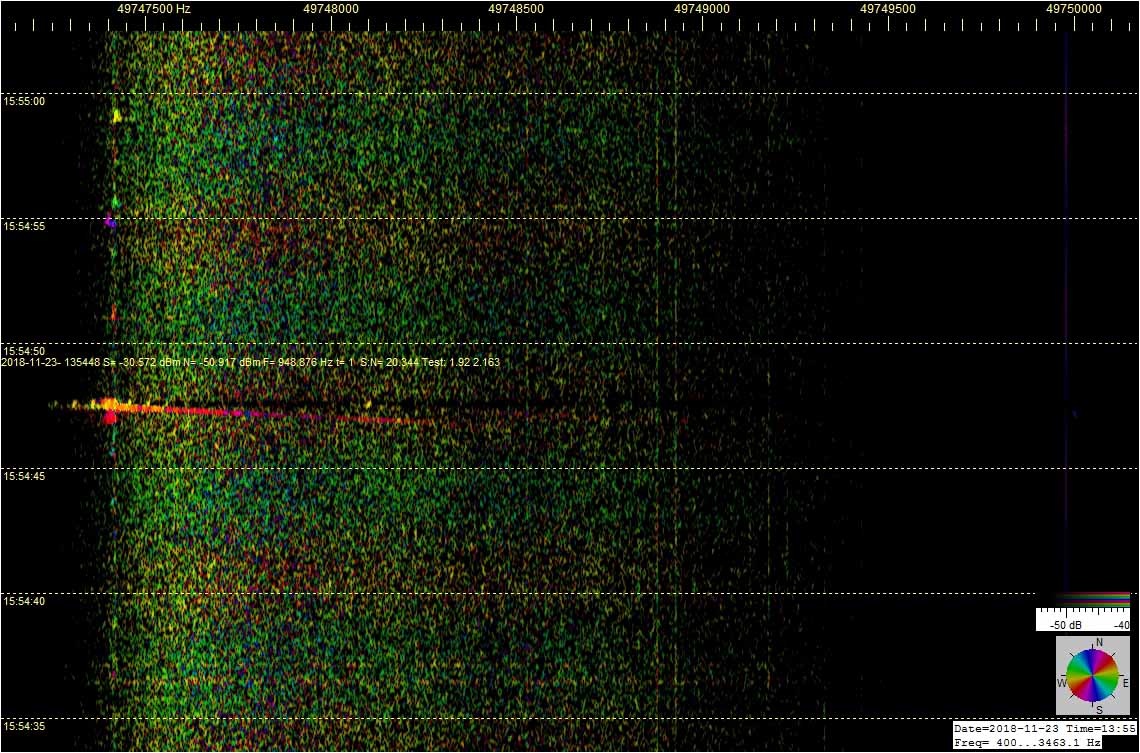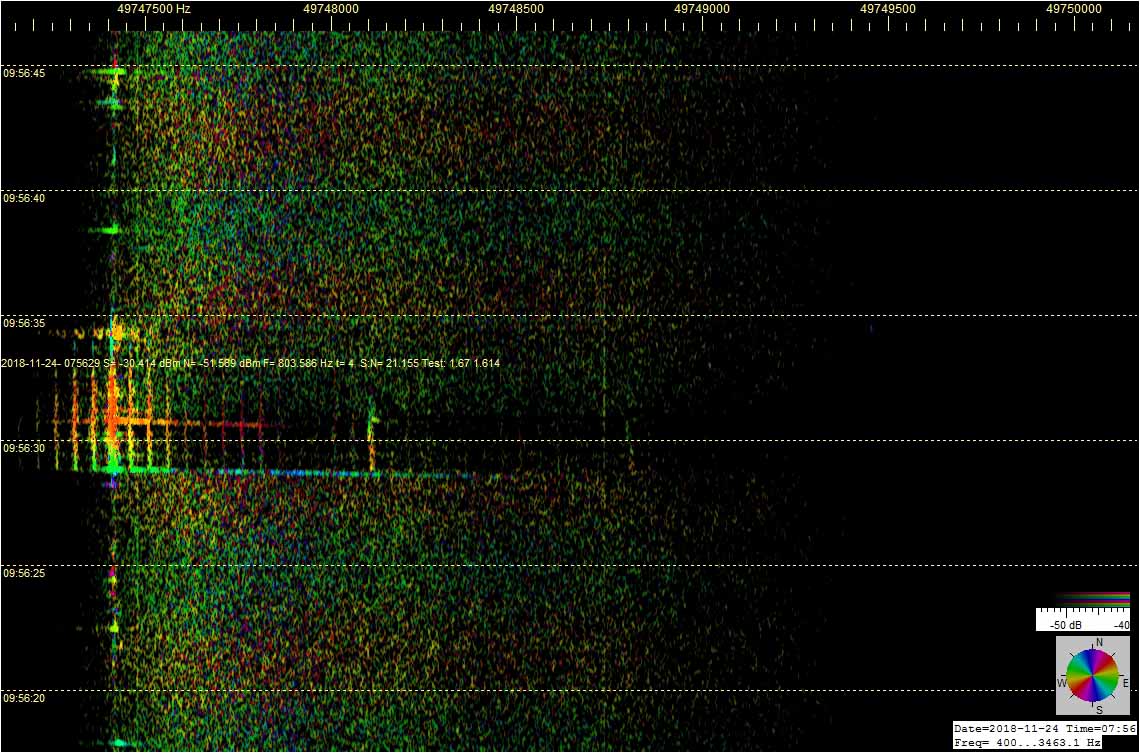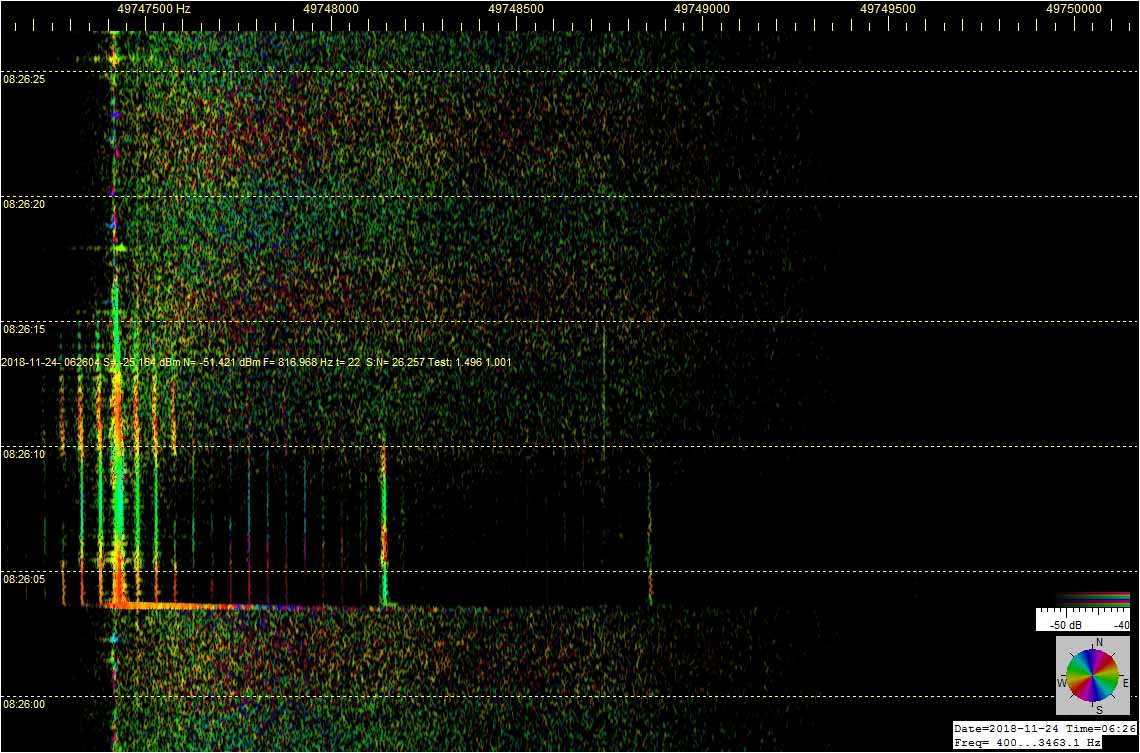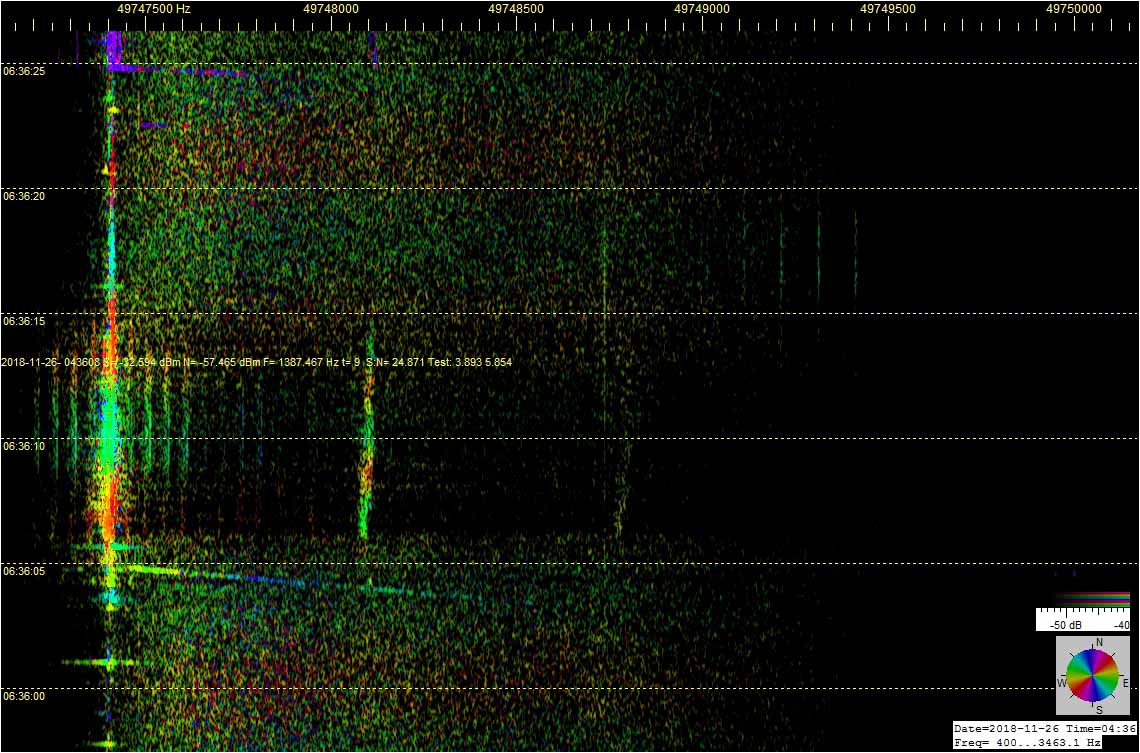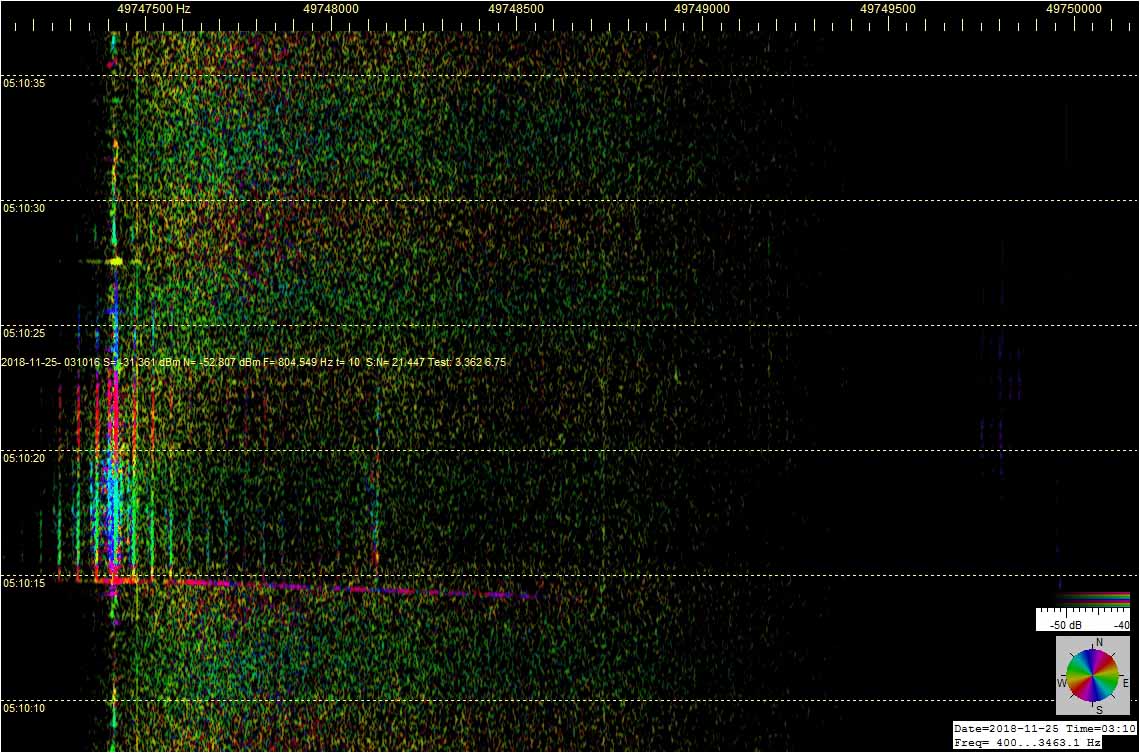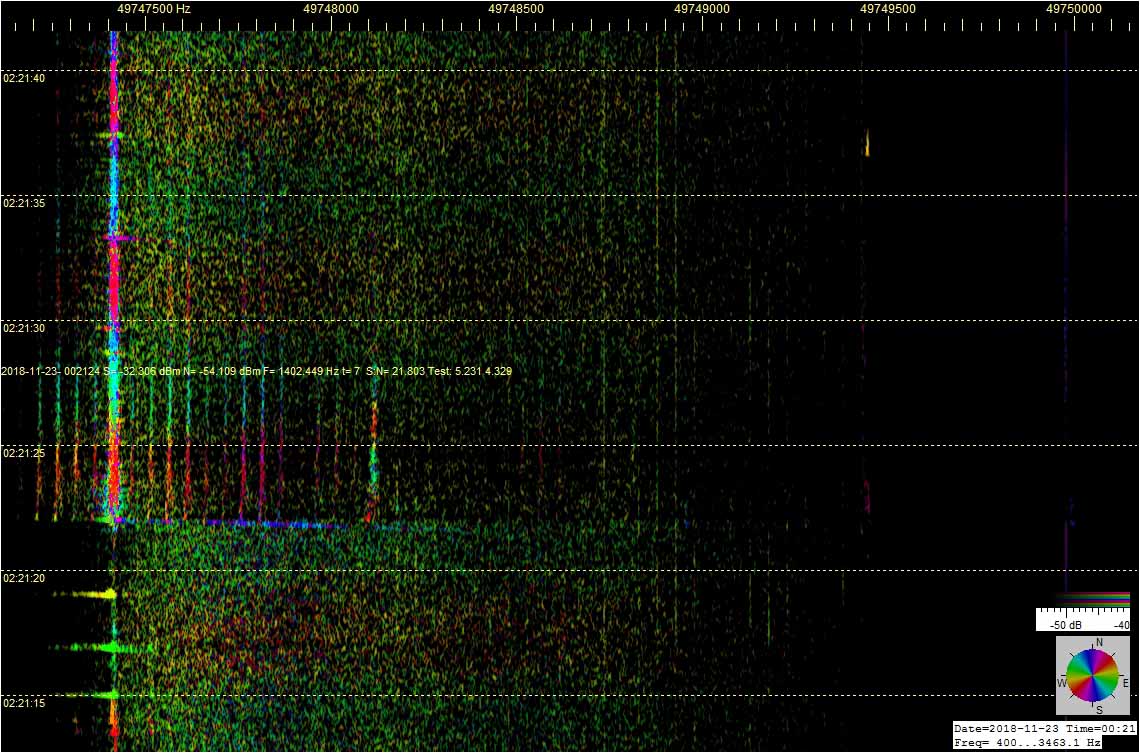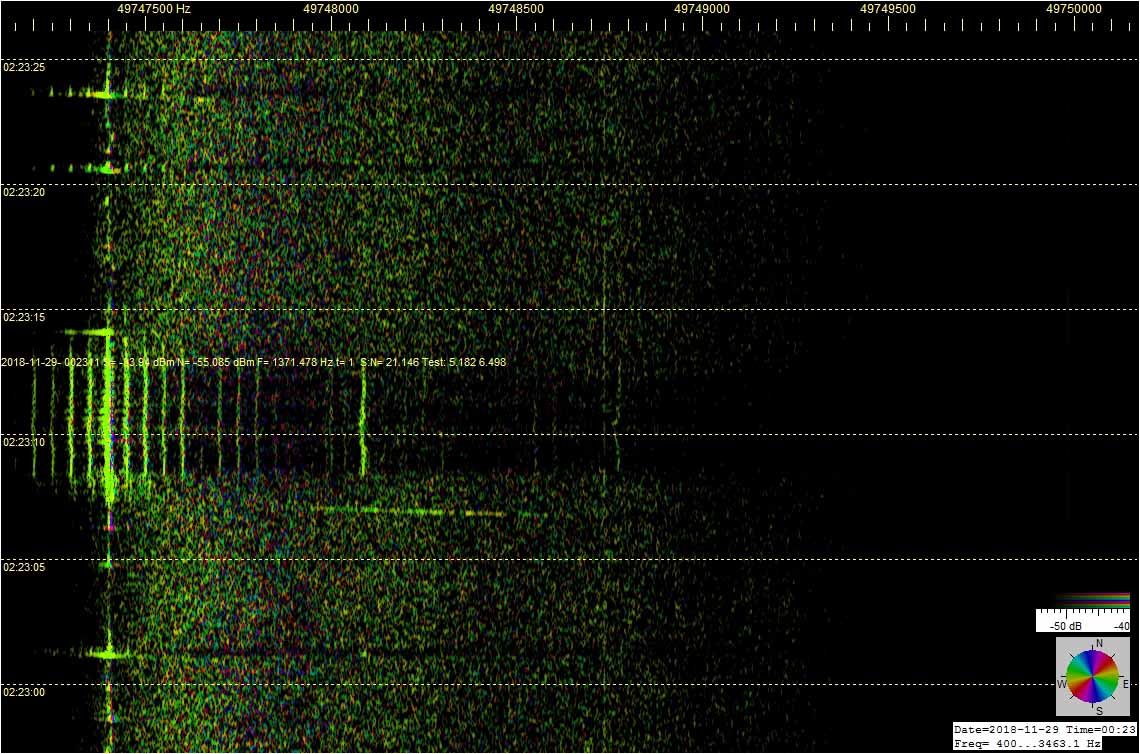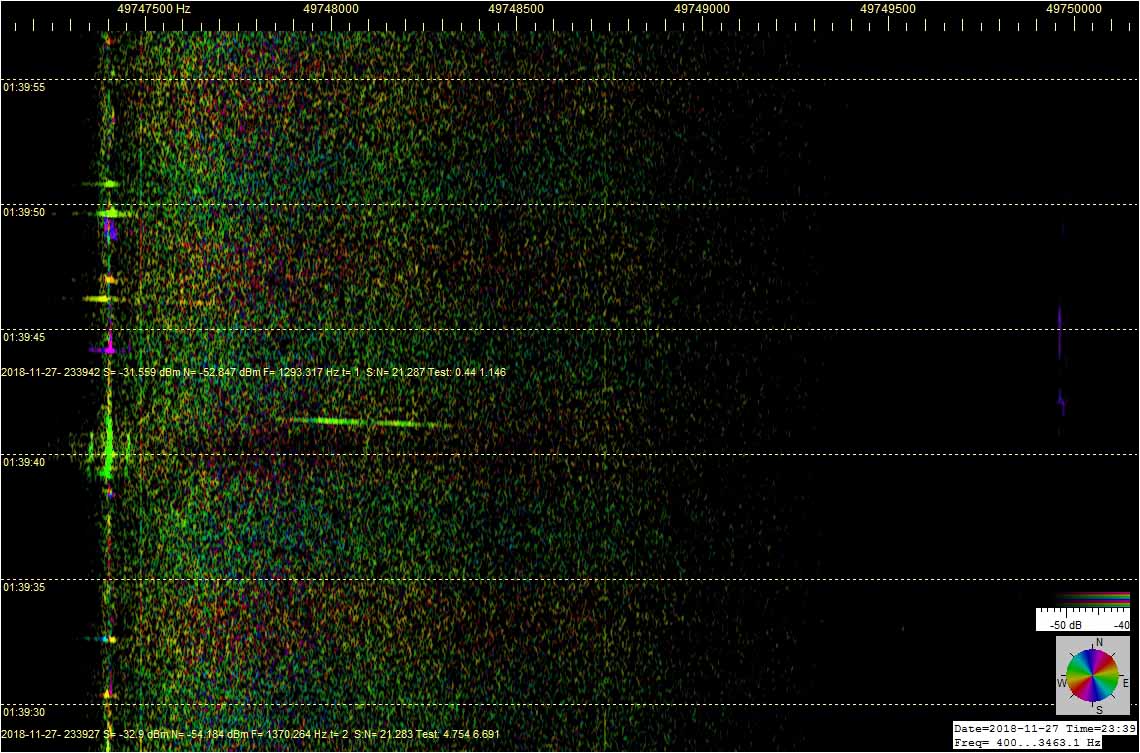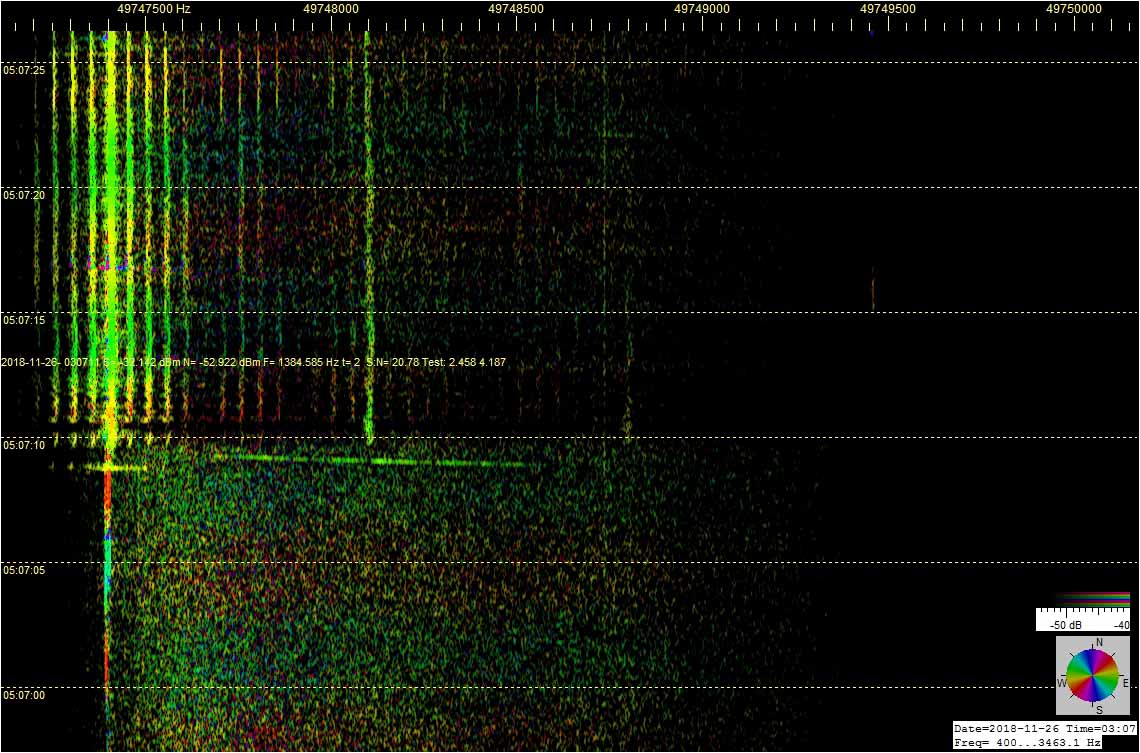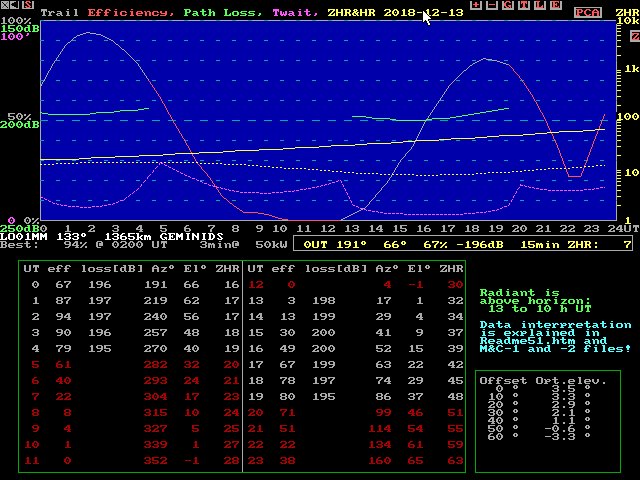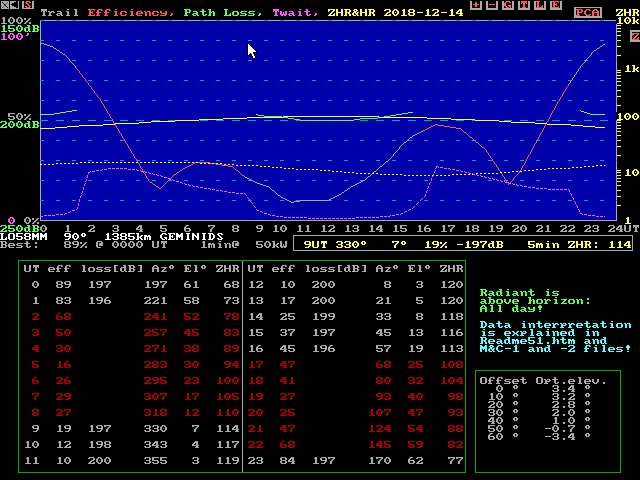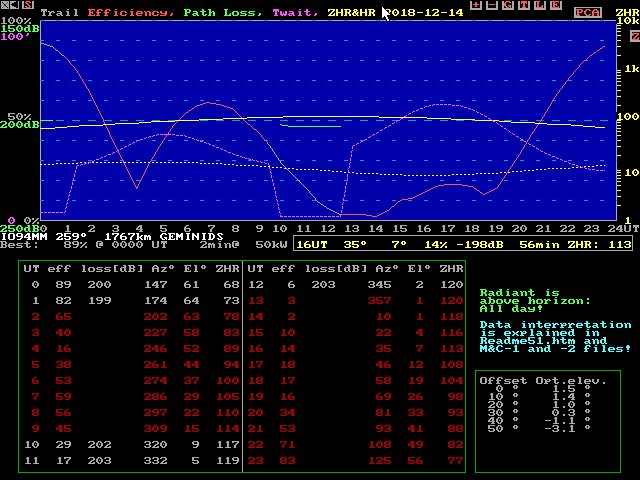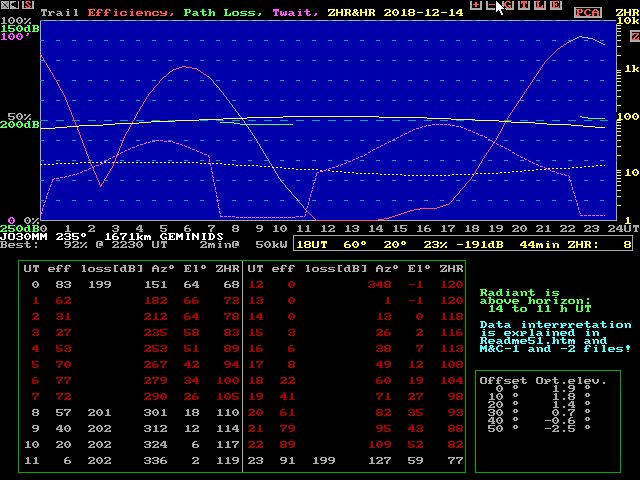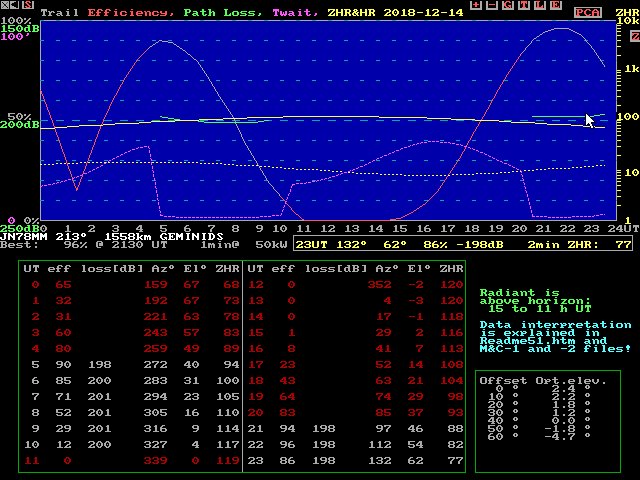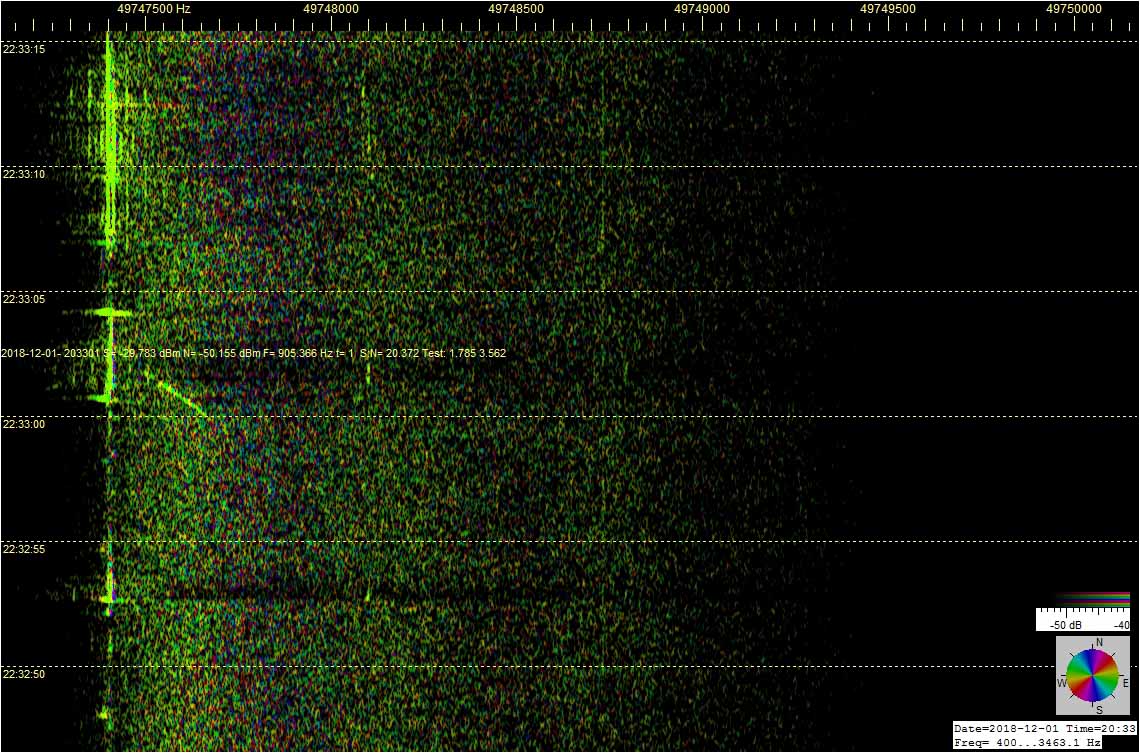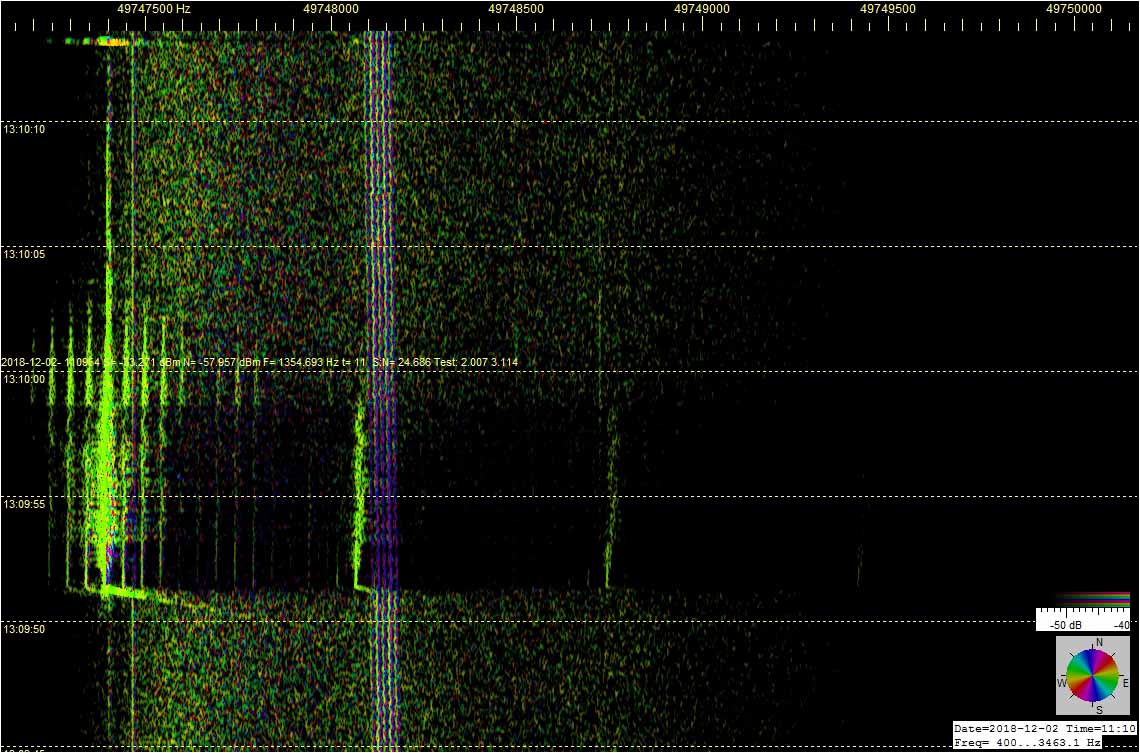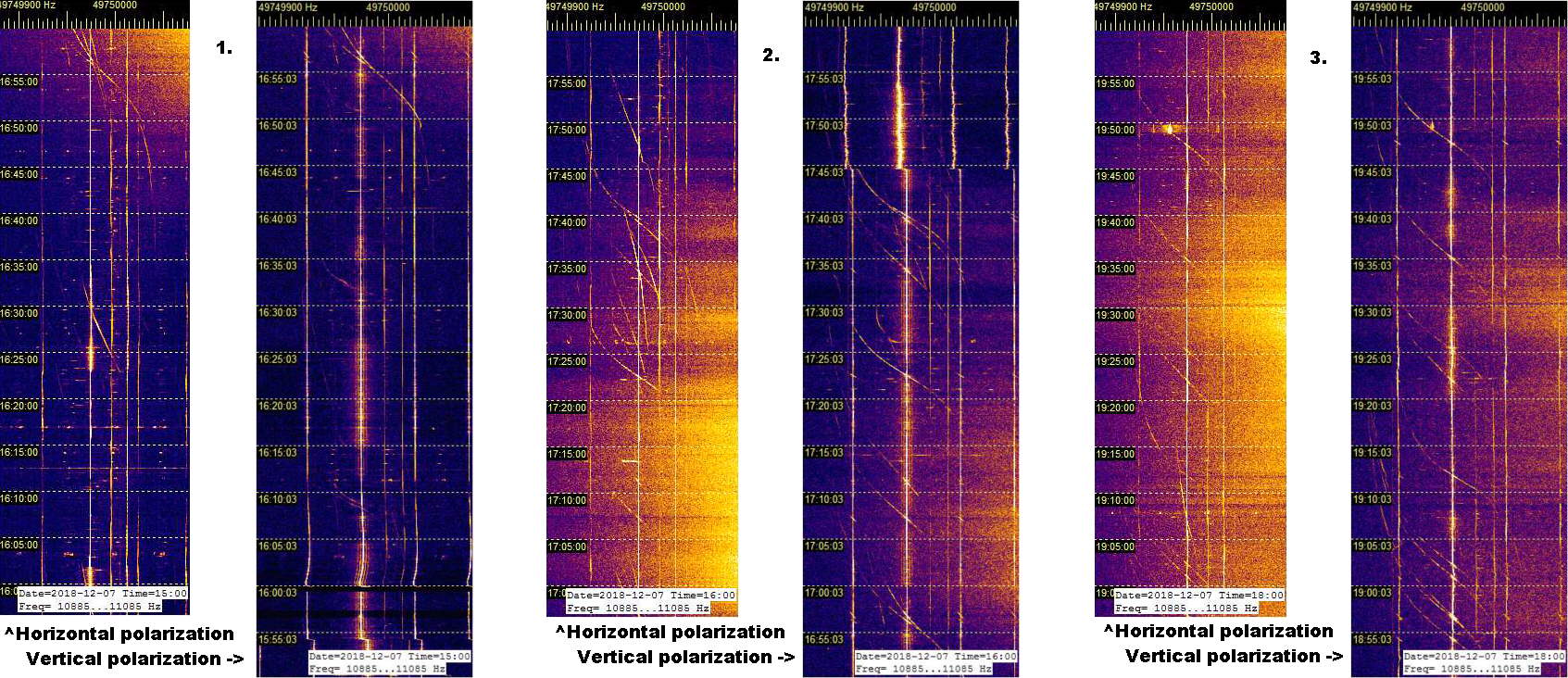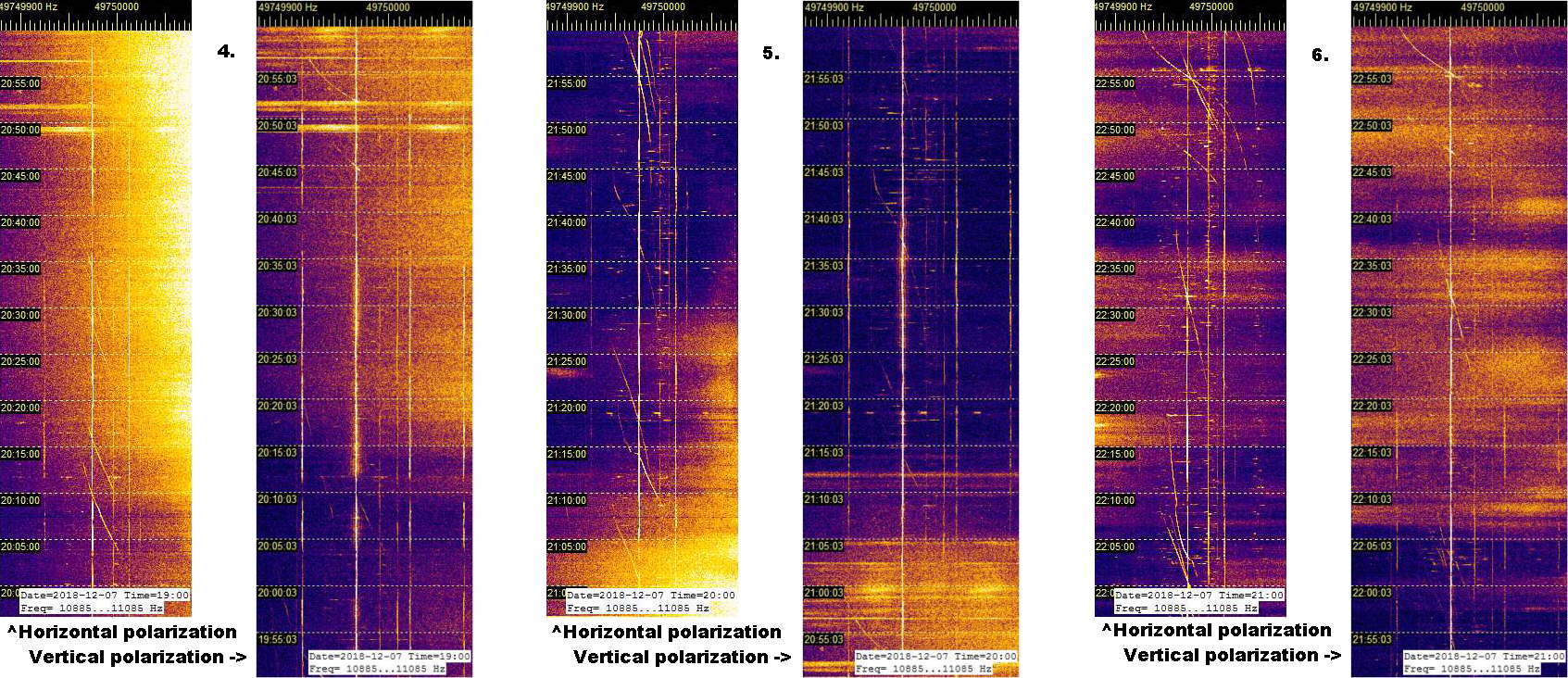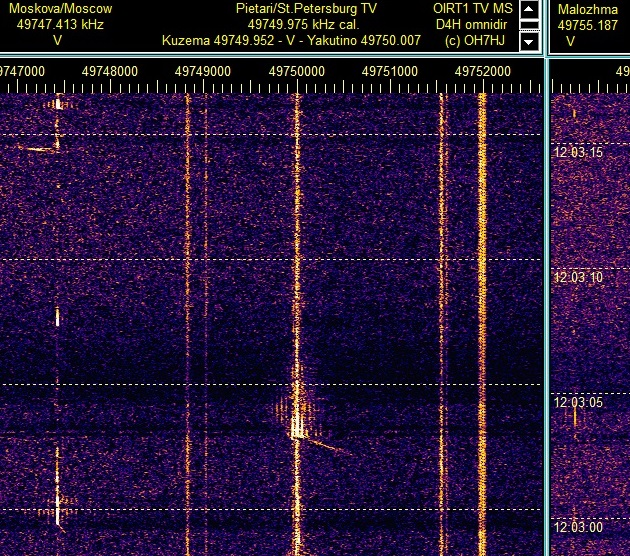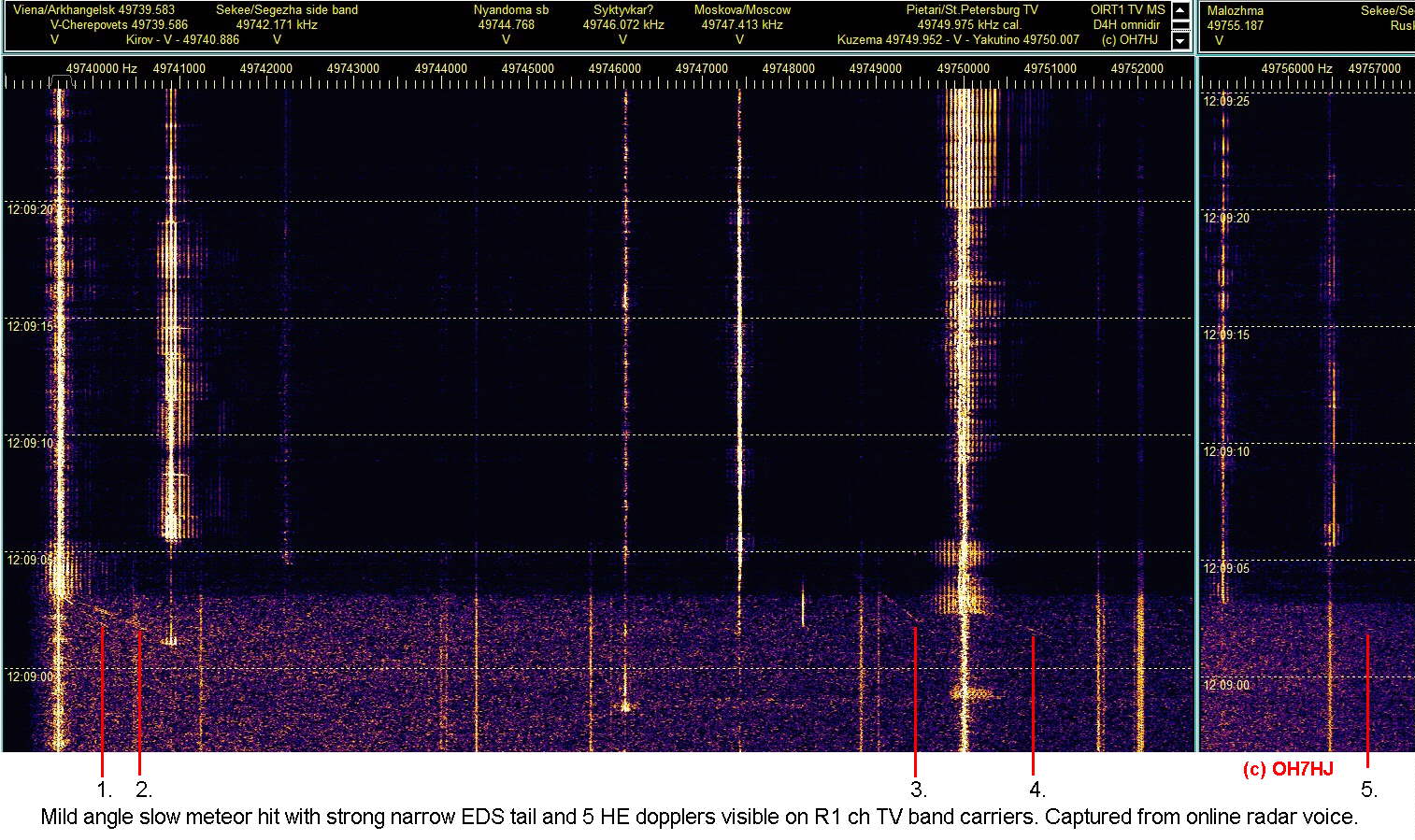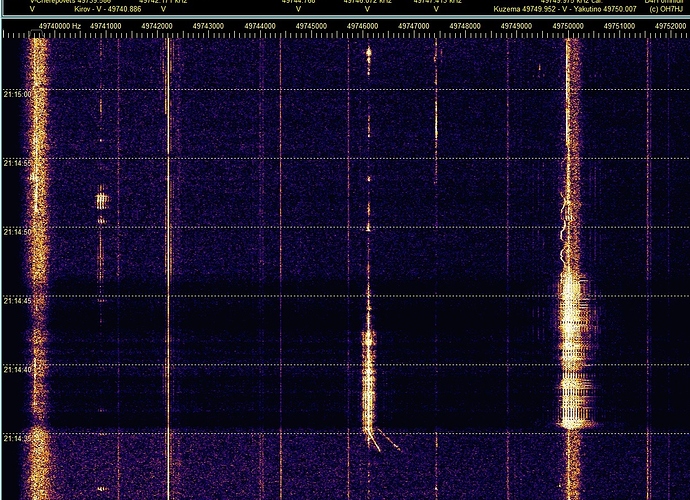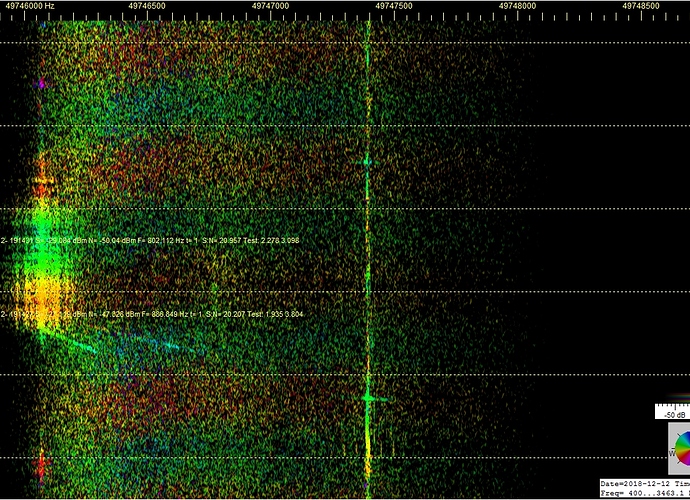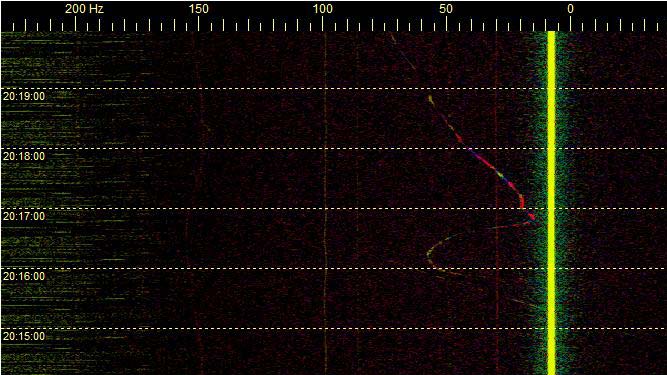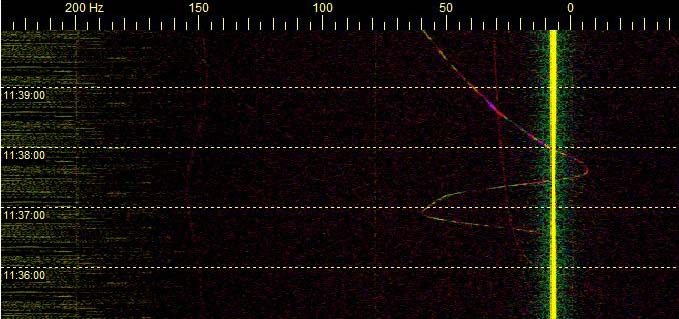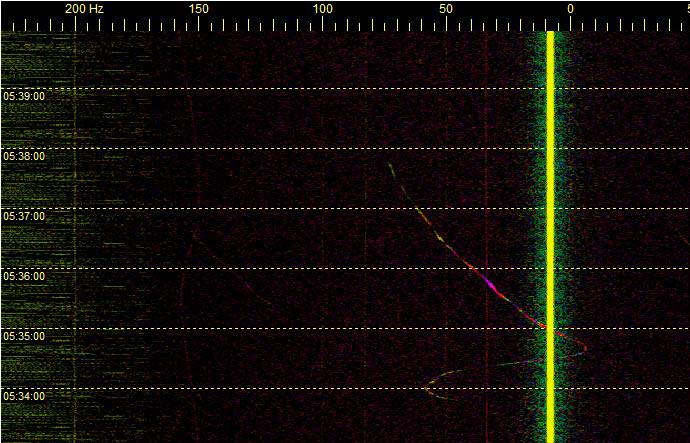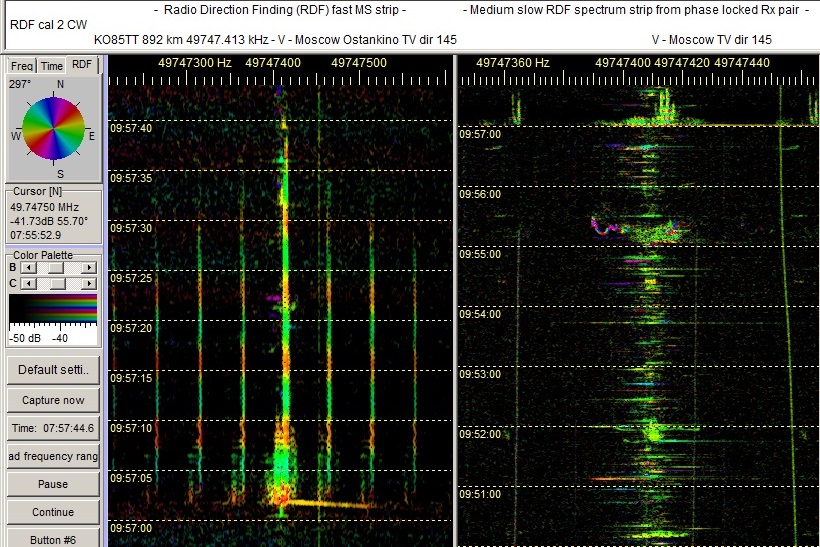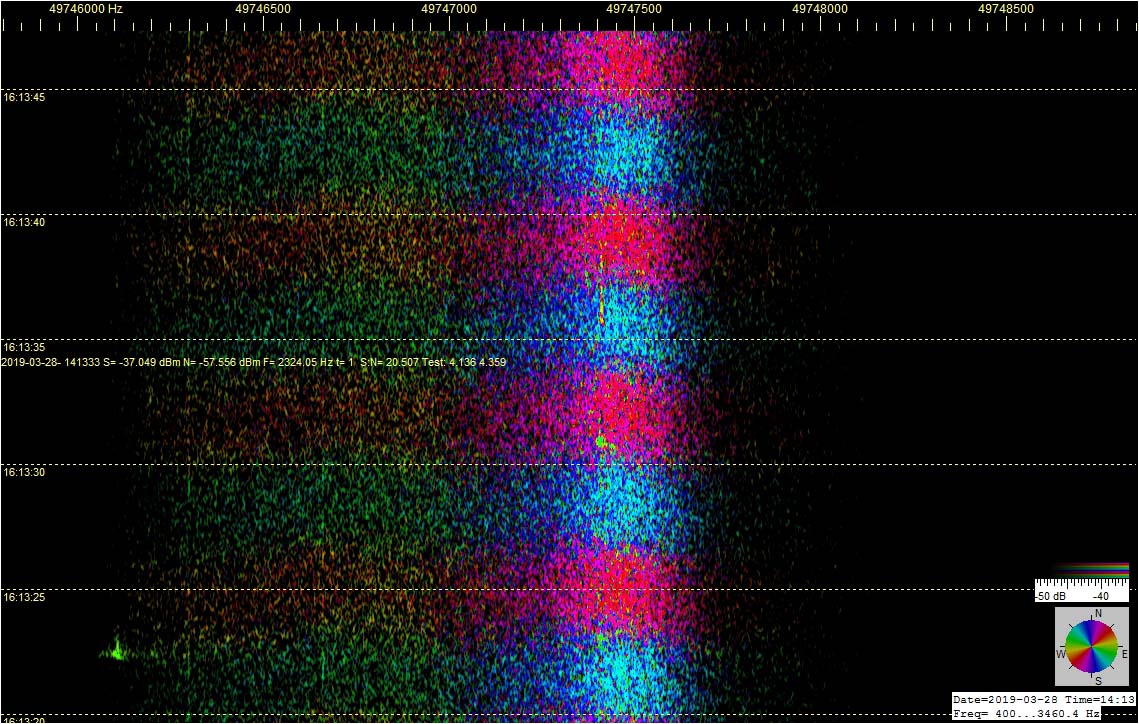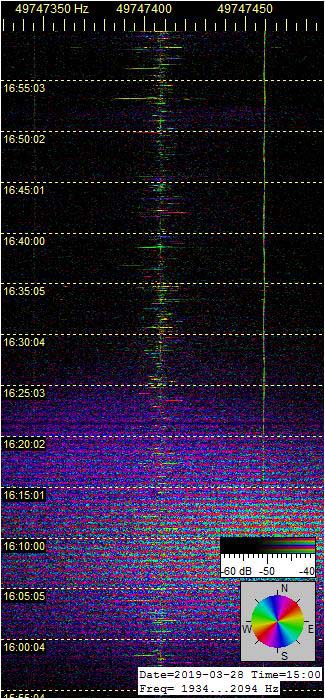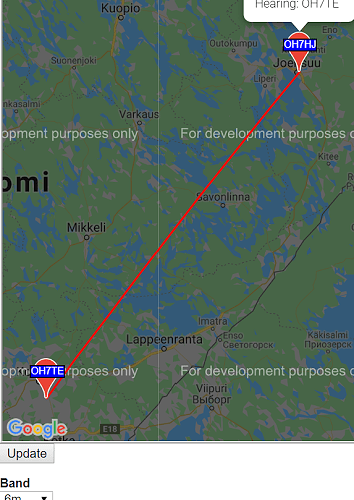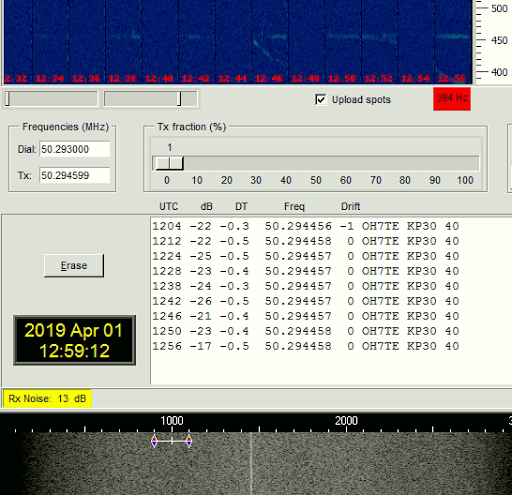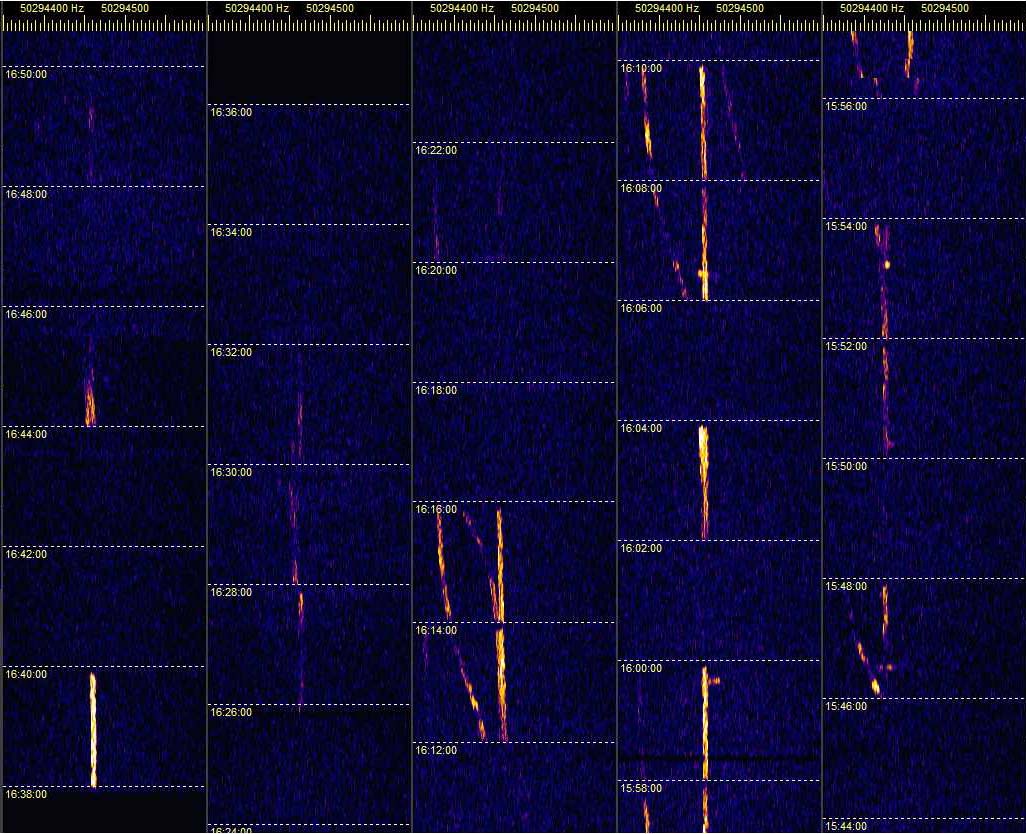[b]Havainto: Auroraheijastuksen polarisaatio vaihtui vaakasuuntaisesta pystysuuntaiseksi.
Eilen pääsin ensi kertaa vertaamaan 6m auroraheijastusta suunnilleen keskenään vastaavien vaaka- ja pystyantennien kesken. Majakoina olivat 6m bandin R1-kanavan TV-lähettimet, jotka lähettävät pääasiassa vaakapolarisaatiossa. Vaaka-antennina oli 4-elementtinen, suuntakuvioltaan dipolia vastaava kaksikeilainen dipolimatto D4H, jonka pääsäteilysuunnat ovat koilliseen ja lounaaseen. Vertailupolarisaation antavana pystyantennina oli puolestaan 4-elementtinen koilliseen suunnattu vertikaalijagi Y4V. Vastaanottimina olivat tavalliset RTL-tikut, tosin bandifiltterien läpi kuuntelevina, ja softina SDR V3 ja Spectrum Lab. [/b]
Revontuli- eli aurorapurkauksen kohinaisena ‘lumisteena’ nauhoilla näkyvä heijastusspektri leviää voimakkaasti. Auroraheijastus onkin yksi kaikkein korkeimmalla tapahtuvista voimakkaista sähkönpurkausheijastuksista (EDS). Minkä korkeammalla yläilmoissa sähkönpurkaus tapahtuu, sen leveämmällä hajaspektrillä se moduloi heijastuvaa radioaaltoa. Alkuvaiheen aurorapurkauksissa kohinaspektri näkyy nauhoilla yleensä oikealla, eli korkean dopplersiirtymän puolella. Korkea dopplersiirtymä merkitsee yleensä havaintovastaanotinta lähestyvää aurorarintamaa.
Ensimmäisissä kahdessa liitekuvassa näkyvät Spectrum Labilla zuumatut yksityiskohtanauhat auroran kautta yleensä voimakkaimmista R1-kanavan TV-lähettimistä. Ensimmäisessä kuvaparissa ovat TV-asemien spektrit aurorapurkauksen alun aikana, vaaka-antenni vasemmassa pienemmässä ruudussa, ja vertikaali oikeassa isommassa. Näistä vertaamalla selviää, että vasemmanpuoleisella horisontaaliantennin spektrinauhalla auroraheijastusten ‘lumisateena’ näkyvät hajaspektrit ovat voimakkaampia. Tuore alkuvaiheen aurorarintama heijasti siis ainakin tässä kokeessa horisontaalipolarisaatiota voimakkaampana.
Ensimmäinen kuvapari: 2018-12-07-1943 FT - Savo-M polarimetry - Comparing D4H to Y4V NE - Aurora © OH7HJ.jpg
Auroran hajotessa polarisaatio kääntyi
Toisessa liitekuvassa näkyy, miten aurorapurkauksen leimahtelevan ja pyörteilevän loppuvaiheen aikana sen voimakkaimmin heijastaman radioaallon polarisaatio näyttää kääntyneen. Tälle revontulipurkauksen hajoamista ennustelevalle loppuvaiheelle ovat ominaisia spektrinauhoilla näkyvien ‘auroralieskojen’ dopplersiirtymän villi vaihtelu korkean ja matalan, eli nauhoilla niiden oikean ja vasemman reunan välillä. Silmin nähtynä tätä revontulten vaihetta kuvataan usein ‘tanssiviksi’ revontuliksi.
Otosparin oikeanpuoleisen ruudun vertikaaliantennilla 6m R1-TV-kanavan lähetinten revontuliheijastukset alkoivat näkyä voimakkaampana, kuin vasemman ruudun vaaka-antennin näkemät auroraheijastukset. Aurorassa saattaa siis tapahtua polarisaation hajoamista ja kiertymistä radioaallon heijastuksessa ainakin tällä 6m VHF-alabandilla?
Toinen kuvapari: 2018-12-07-2252 FT - Savo-M polarimetry - Comparing D4H to Y4V NE - Aurora © OH7HJ.jpg
Kolmannessa liitekuvassa on vertailun vuoksi samasta aurorapurkauksesta hitaan spektrinauhan tallenne ‘raakana’ jatkuvana R1-TV-kanavan spektrinä. Siinäkin näkyy auroraheijastuksen voimakkuuden kasvu oikeanpuoleisen kuvan vertikaaliantennilla purkauksen loppuvaiheessa, eli nauhoissa ylhäällä.
Kolmas kuvapari: 2018-12-07-2335 FT - Savo-M polarimetry - Continuous R1 spectrum view - Comparing D4H to Y4V NE - Aurora © OH7HJ.jpg
Mistä pystypolarisaatio auroraheijastukseen?
Aurorapurkauksen alun voimakkaimmin vaakapolarisaationa heijastuvaa aalto on ymmärrettävä, koska kaikki voimakkaimmat 6m R1-kanavan TV-lähettimet lähettävät horisontaalina. Polarisaation kiertyminen loppuvaiheen aurorapurkauksessa on vaikeampi ymmärtää. Kun ajattelee revontulipurkauksen syntytapaa suurjännitteisenä sähkönpurkauksena ionosfäärin ja voimakkaasti varautuneen aurinkotuuliympäristön välissä olevassa pystysuuntaisessa sähkökentässä, niin ilmiöstä saattaa päästä jyvälle.
Aurorapurkauksen verhomaisen rakenteen muodostavat, suurjännitteisen sähkökentän kiihdyttämien ilmaionien parvet muodostavat pystysuuntaisia ionisaatiovanoja, jotka silloin ymmärrettävästi heijastavat vertikaalipolaroitua radioaaltoa. Kukin lukuisista suurjännitekentässä kiihdytetyistä ilmaioneista muodostaa hetkellisen pystysuuntaisen ionisaatiovanan. Koska aurorapurkauksessa tämä luonnollinen sähkökenttä kiihdyttää lukemattomia ioneja samanaikaisesti, ne yhdessä muodostavat silmillekin näkyvän revontulipurkausverhon pystysuuntaiset säikeet.
Nauhoilla näkyvää radioheijastusta kohinalla hajaspektriksi moduloiva ilmiö saattaa aiheutua revontulipurkauksen lukuisten yhtaikaisesti kiihtyvien ionien radioheijastukseen aiheuttamista dopplersiirtymistä. Silloin hajaspektrin leveys mahdollisesti kuvaa revontulipurkauksen kiihdyttämien ilmaionien nopeusjakaumaa.
Vielä jää selittämättä mahdollinen vaakapolarisaation kiertyminen pystypolarisaatioksi. Samankaltaisia polarisaation muutoksia on aikaisemmin havaittu mm. HF:llä jyrkissä ionosfääriheijastuksissa. Myös auroraheijastuksessahan on kyse jyrkästä takaisinheijastuksesta, eli NVIS. Tällä videolla Matti OH7SV esittelee ionosondiluennossaan radioheijastuksen kiertopolarisaation suunnan jaksottaista vaihtumista HF-alabandeilla: youtube.com/watch?v=AoOoOXNO8K4
T: - Juha OH7HJ
Kaikkia liitekuvia on voimakkaasti pienennetty, että ne mahtuvat nettisäikeen kokorajoihin. Sri mittaustietsikoiden eri kokoisista näytöistä johtuva vaaka- ja pystypolarisaatioruutujen kokoero!
[b]In English:
6m Band Aurora Scatter Shifted its Polarization
Setting up multi Spectrum Lab windows with different settings sharing and plotting from the same signal source it is easy to monitor simultaneously as well high speed meteor scatters as slower natural high sky scatters. In this experiment I did a simple polarimetric comparison of 6m band R1 channel TV carriers scattering back from aurora (Aurora Borealis, Northern Lights) discharge front. [/b]
The result of the observation was that at least this aurora discharge scatter (ADS) appeared to shift the dominating polarization of 50 MHz scatter from horizontal at discharge early stage to vertical at its late stage.
Natural high sky electric discharges like ionospheric lightnings appear to modulate radio waves scattering from them with noise, creating a characteristic spread noise spectrum of electric discharge scatters (EDS). These multi-static radar observations suggest that high altitude natural electric discharge radio scatters on low VHF have a wider distinctive spectrum spread than those scattering from lower altitude discharges like Es.
Aurora Scatter Phases
As a very high altitude discharge the aurora discharge scatter has very wide spread noise spectrum. In the beginning and early stage of the aurora discharge it scatters 6m wave usually with high doppler shift which makes the aurora spread noise spectrum ‘cloud’ appear rather steadily to the right of TV carriers at these strips. This may indicate aurora discharge front gradually spreading from North to South towards the observing receiver.
Later as the aurora discharge has ceased spreading southwards it shifts to the latter stage of rather rapidly flaring discharges. Aurora watrchers usually describe this latter phase as “dancing Northern Lights”. On the spectrum strips the aurora noise spectrum shifts wildly between high and low doppler shifts every few minutes. Eventually the discharge fades out.
Using aerials roughly comparable by their gains towards aurora front, the early phase of aurora discharge scatter appeared to reflect horizontal ADS with stronger signal than vertical. This is easy to understand because majority of R1 TV Tx’s are horizontally polarized. However, at the latter flaring phase of the aurora it started to scatter vertical polarization stronger. This polarization shift is more difficult to understand.
Polarization Shift Mechanism?
Comparing to HF band ionosonde observations, it is known that on low HF bands the ionospheric backscatter i[/i] wave shifts periodically its circular polarization between right and left hand. So there is regular polarization shift happening in ionosphere. This experiment suggests that aurora discharge backscatter may create similar polarization shifting effects on low VHF as regular ionospheric backscatter does on HF.
I have no access to ‘real’ polarimetry measuring software allowing complete measuring of linear and circular polarizations. So I made the aurora scatter experiment this amateur way as simple comparison between linear polarizations.
Attached are sets of Spectrum Lab strips of early and late phases of aurora discharge scatter. At each there are pairs of screenshots, the left smaller one illustrating horizontal aerial and the right larger one vertical aerial ADS’s. Direction of strip movement is from up to down. Screenshot sizes are strongly reduced and compressed from originals to fit file size limits of attachments.
Regards, - Juha OH7HJ
